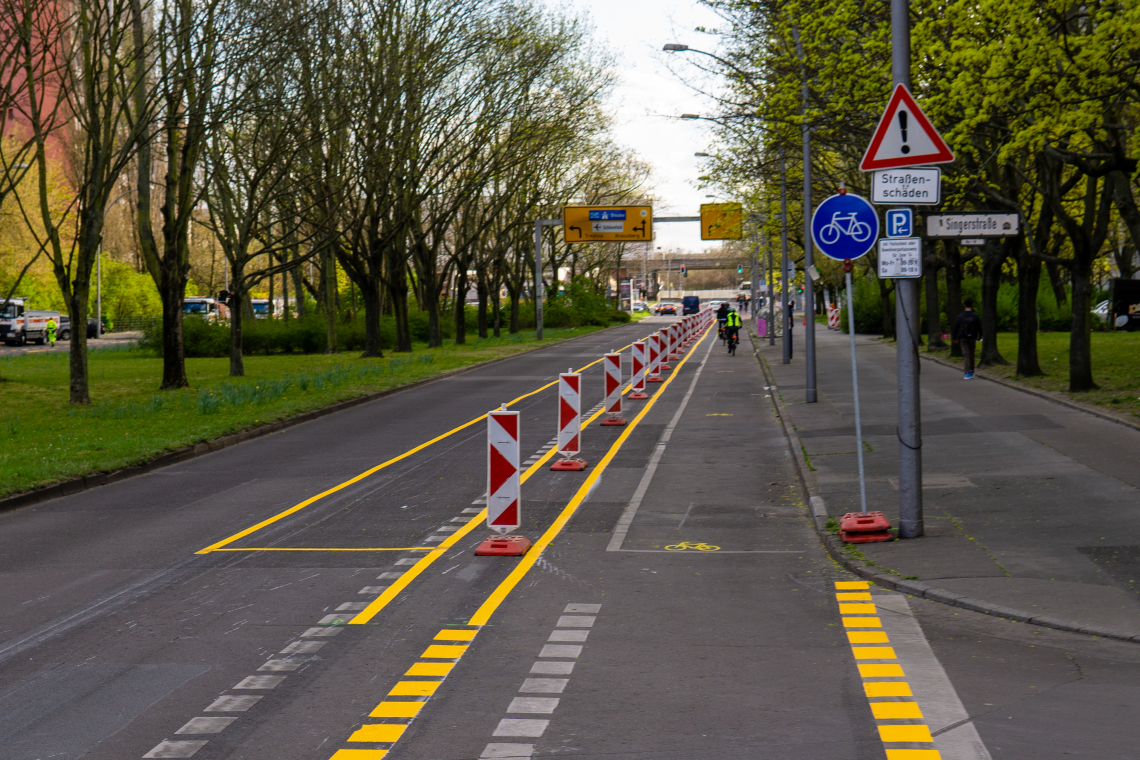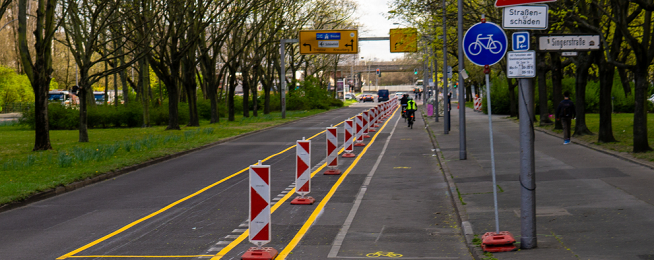In 2018, the Berlin city government passed the Mobility Law in response to a citizen‘s referendum campaign. A first in Germany, it mandates the roll out a high-quality, city-wide network of cycling infrastructure. Jody Betzien spoke to Dirk von Schneidemesser, from Changing Cities, about recent successes and challenges for cycling advocates in Germany.
JB: For international observers, Northern Europe, and to some extent Germany, is often regarded as a model for urban cycling; the kind of place where it’s an “everyday” activity and even your grandparents still ride. Do you think that’s an accurate assessment?
DvS: I refer to cycling in Germany as a mobility practice that is ‘normalised but marginalised.’ Normalised because it is accepted and acceptable that your grandparents might cycle for everyday activity. You’re also not surprised to see someone in a pants suit cycling through the city and parents transporting their kids in a cargo bike. Marginalised because even though it’s normal and accepted, cyclists do not get the same privileges as motorists. Legally and in terms of investment, cyclists come up short in Germany. Traffic law is only beginning to recognise cyclists as legitimate users of traffic infrastructure, and the financial resources for cycling in Germany aren’t even a drop in the bucket.
In Berlin, people cycle more than the national average. Cycling here is accepted … until it gets in the way of motorists’ privileges. Politicians have been saying for years that we need to support cycling in Berlin, then they realise that that means redistributing traffic space, money, and public resources like traffic planners. And then they back down. That’s why you see more younger males cycling than other more risk-averse groups, and you certainly don’t see children riding their bikes to school alone.
Over the last decade, cycling has grown significantly in Berlin to just over 18% of all trips while car use has declined to around 24%. Much of this growth happened prior to any major improvement in cycling facilities. What do you think has been driving this shift?
Cycling is convenient. Berlin wasn’t really growing for some time, around 20 years ago Berlin’s population even declined a bit. Recently though, more people are coming to Berlin, it’s getting fuller. That goes for traffic space too. Car registration continues to rise, while the space for storing private cars in public space remains the same. Car traffic is getting worse. Who wants to spend more than a week of their life each year stuck in traffic? Imagine, an extra week! You could try to negotiate an extra week of vacation with your employer, good luck, or you could just sell your car and buy a bike. While I don’t think most people see it exactly like that, I do think that it’s a pragmatic motivation for most folks.
Cycling advocates have been campaigning for improved facilitates in Berlin for decades. What sparked the decision to launch the Bicycle Referendum campaign in 2016.
We realised that diving into administrative guidelines and having nice talks with politicians didn’t work.
Almost everybody in politics agreed with us when we met them and said: “hey, we need better cycling infrastructure!”. And then nothing happened. For years. For many of us who were really involved in the Bicycle Referendum I think the climate crisis was a real motivation. Also, cyclists safety. But the climate crisis set the scale of the task: we need to get the 80-90% of people for whom it’s easily possible out of their cars and on bikes.
For that, we don’t need to focus on making cycling more attractive for those who are cycling already, which I think is a real trap that a lot of cycling advocacy falls into. We need to make cycling attractive for those who don’t yet cycle. That was the motivation behind the law that we wrote. The main achievement of the Bicycle Referendum campaign is the Bicycle Law, Germany’s first, passed as part of the Berlin Mobility Law in 2018. There are now more than 40 cities in Germany who are pursuing or have already had success with cycling referendum initiatives.
The campaign was hugely popular, gathering over 100,000 signatures in a few weeks. Why do you think it was so successful?
The citizens of Berlin – and Germany for that matter – are unhappy with current mobility policy. They demand a change, and we as Changing Cities offered a clear path with the Bicycle Referendum. There are more than 3,000 people killed by traffic violence in Germany each year.
Air pollution costs each citizen on average 1,250€ per year. Every kilometre cycled causes health benefits of 0.50€ for society. People are aware of this stuff. More than 40% of Germans would like to cycle more. Only 7% have ever cycled on a protected bike lane. That’s a problem: people would love to cycle more if they felt safer doing it.
The “Mobility Law” is very ambitious, mandating protected cycling lanes on all major streets and a 100km “bicycle highway network”. Almost three years after adoption there is growing frustration at the pace of implementation. What do you think is behind this slow progress?
In Berlin the public administration fell victim to austerity policies. There are simply too few public servants to handle big important tasks, and that’s a problem not just for building bike infrastructure. Also, the people we have in the administration are older than the average, and they were trained mainly to build the car city.
In that sense, it’s a management problem, our elected representatives are the ones who need to manage this transformation process, and that also means transforming the administration. The Green Party is now in charge of Berlin’s traffic administration. They have failed to initiate the necessary changes and recognize the scale of the task. I’m not saying it’s an easy task, it’s certainly not. There is one district of twelve in Berlin that shows promising signs, Friedrichshain-Kreuzberg, and you can see the results. But one in twelve is certainly not enough.

During the Corona pandemic, Berlin, like many cities around the world, reallocated road space to install bicycle lanes, enabling safe and socially distanced travel. At the same time the pandemic has also been associated with increased car usage and lower public transport patronage. How do you view the longer-term impacts of the pandemic on mobility in cities?
Well, I think that people might commute less in the future. That doesn’t necessarily mean they will be less mobile. What is important to take away, I think, is that it is possible to make big changes in a short period of time. We worked with the district of Friedrichshain-Kreuzberg, and they were able to quickly make close to 15 kilometers of pop-up bike lanes as a response to the coronavirus pandemic, even before other European cities.
That shows that it’s possible to do transformations more quickly than we generally think possible. At the same time, 15 kilometers is too little to meet the goals in the Mobility Law for 2030, for which Berlin would need to be implementing 250 km of bike lanes on main streets per year. So I hope that the learning from the pandemic is that we can make these transformation processes go faster, and that we will begin to do that. Not only in Berlin.
Many Germany cities have committed in principle to a “Verkehrswende”, or mobility transformation, as part of climate action. What do you see as the main challenges to this becoming a reality and what role do you think cycling can play?
I think the main challenge is that a mobility transformation is not something that you add on top of existing mobility practices. You have to take away privileges from “motordom”. The privileged position of the car has been around for so long that it’s really deep inside us. We accept it as normal and justified. And when someone suggests a change, we perceive it as a threat.
For example, there is only one thing that is really allowed on streets, which make up the majority of our public space: cars. Nonetheless, when we open a street for numerous activities, socializing, commerce, social-oriented activities, sports, people talk about the road being closed. Closed!? So the situation in our heads is that when anybody can safely be in a space and practice a huge spectrum of activities, the road is closed, and when you can only do cars in that space, it’s open? This is deep within our culture, and that’s hard to change. For most people, the German word for ‘bicycle highway’ is Fahrradautobahn, directly translated, that means ‘bicycle car highway.’
Despite the growing popularity of cycling for daily transport, in 2020, 18 cyclists lost their lives riding on Berlin’s streets; almost triple the previous year. What do you think is behind this increase and can be done to prevent further tragedy?
I think that the more reliable indicator of safety is the serious injuries, which remain very high over the years, and continues that way today. Often there is a very thin line between killing and seriously injuring a cyclist with motor vehicle. Our infrastructure, which leads to heavy motor traffic invites traffic violence. Authorities actually dismiss measures, like separated signals or protected intersections, with the argument that it would cause traffic. What they’re really saying is that maintaining a streets capacity for motor vehicles is more important than saving lives and preventing injuries. If you want to prevent further tragedy, reduce speeds and make safe intersections. The Dutch have done well with their intersection design, which we call protected intersections. It’s not something that has to be invented, it’s something that has to be implemented, again at the cost of some of the comfort of driving a car.
Jody Betzien is a Master of Environment graduate, enthusiastic about sustainable urban mobility and the role of cycling in a zero-carbon future. He is a contributing author to a study investigating ethical principles for street space distribution and is currently engaged in research examining high street retailer perceptions of the way customers travel. Currently based in Berlin, he loves to ride his bike across the European Alps whenever the opportunity arises.
Become our friend
Find out more about Bicycle Network and support us in making it easier for people to ride bikes.


